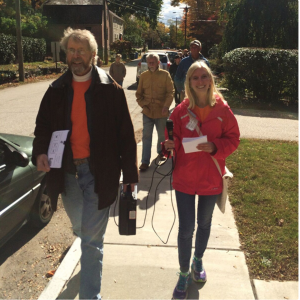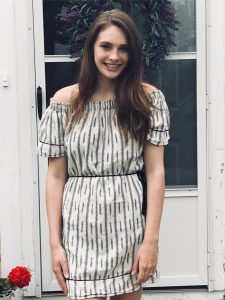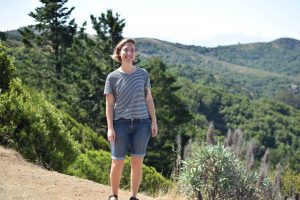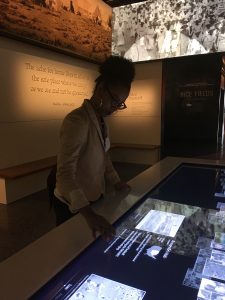The Department is pleased to share that first year doctoral student Kathryn Angelica received a fellowship from the Frank C. Munson Institute of American Maritime Studies at Mystic Seaport to take classes and conduct research this summer. The courses, of which Angelica will choose two, include: “America Goes to Sea,” Maritime History Survey Course, “American Maritime History Seminar,” or an independent research course using materials from the G. W. Blunt White Library. The Cora Mallory Munson Scholarship covers tuition and room/board for the summer.
Student Achievement
PhD Nicole Breault Receives AHA Research Grant
The Department is very pleased to share that Nicole Breault, a third year PhD student, has won a 2019 American Historical Associaton (AHA) Littleton-Griswold Research Grant. The grant supports research in US legal history and in the broader field of law and society. Nicole will be utilizing the funds to further her dissertation project, “The Night Watch of Early Boston: Law and Governance in Eighteenth-Century British America.”
For more information, please click here.
PhD Student Megan Streit Wins Boren
Congratulations to Megan Streit who has received a David Boren Fellowship from the US Government’s National Security Education Program (NSEP)! The award of $24,000 will enable Streit to undertake advanced language training and valuable dissertation research in the Ukraine from January to September 2020.
Congratulations Amy Sopcak-Joseph!
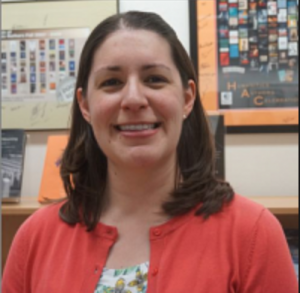 The Department is very pleased to announce that Amy Sopcak-Joseph will begin this fall as an Assistant Professor of History in the Department of Global Cultures at Wilkes University in Wilkes-Barre, PA!
The Department is very pleased to announce that Amy Sopcak-Joseph will begin this fall as an Assistant Professor of History in the Department of Global Cultures at Wilkes University in Wilkes-Barre, PA!
Amy’s dissertation, titled “Fashioning American Women: Godey’s Lady’s Book, Female Consumers, and Periodical Publishing in the Nineteenth Century,” explores the production, dissemination, content, and reception of Godey’s Lady’s Book, an exceptionally popular antebellum American periodical. The final drafting of her dissertation has occurred at the University of Connecticut Humanities Institute (UCHI) where Amy has served as a fellow for the 2018-2019 school year.
Amy also has a forthcoming article in Book History that received the Graduate Student Essay award by the journal’s editors. The essay, “Reconstructing and Gendering the Distribution Networks of Godey’s Lady’s Book in the Nineteenth Century,” will appear in the 2019 volume of the journal, which will be published in November.
Congrats, Amy!
Undergrad alum Regan Miner named part-time Executive Director at NHS
Regan Miner, UConn History Major and class of 2013, was named part-time Executive Director at the Norwich Historical Society (NHS). Miner, a Norwich native, previously served as a consultant to the NHS during which she amassed over $120,000 in grant funding over the span of six months to restore the 18th Century Daniel Lathrop Schoolhouse, now home to the Norwich Heritage andRegional Visitors’ Center, to create the “Discover Norwich” exhibit, and to organize the Walk Norwich Self guided trails.
With a Master’s degree in public history from Central Connecticut State University, Miner also serves as part-time associate director at the New London County Historical Society. In 2016, she received the 40 under 40 Award and the Connecticut Governor’s Conference on Tourism Rising Star Award. In 2018, she added the Mimi Findlay Award for Young Preservationists to her list of accomplishments.
PhD Student Lauren Stauffer Contributes to Made By History
Utilizing research from her dissertation, third-year PhD student Lauren Stauffer contributed an op-ed, titled “How President Trump Shattered the Bond Between Republicans and NATO,” to the Washington Post’s Made by History column. The article compares the Republican Party’s longstanding support for NATO, particularly under President Ronald Reagan, to the current relationship between the alliance and President Trump.
Take History BACK from White Supremacists
by undergraduate student, Rohit Kandala ’19
On March 15, 2019, the world stood in silence as 50 people were massacred and 50 more were injured in the Christchurch mosque shootings. I remember waking up that morning and staying silent for a couple hours as the news reports started to pour in. Throughout the entire ordeal, what saddened me most was that Christchurch wasn’t a surprise—and no one can pretend that it was a coincidence.
Luckily, most media outlets no longer phrase the systematic and global problem of white supremacy as a “rising threat”—it’s already clear that it’s here and it’s not a fringe movement. But, this article isn’t about white supremacy as much as it is about how history has been kidnapped and corrupted by this movement to serve its perverse needs. Misinformation is the problem.
Before I go further, I have two conditions: I will not list the perpetrator’s name as that is exactly what he and his movement want and I will list two assumptions I have:
1. Currently, History is expressed through more mediums than ever. While, K-12 education is still formative, online mediums like Facebook & YouTube are increasingly used more often either for education or entertainment. Unfortunately, most of weaponized history also occurs on these new and less regulated platforms.
2. Fortunately or unfortunately, History is fluid & is constantly re-shaping itself. This results in different interpretations over time, and people can exploit that to create the representation they’d like.
Both these statements, which I hold to be true, have wide-ranging effects on History and how it’s understood.
First off, the fact that history is now more accessible because of advances in digital communications is a great thing! In fact, it’s a cost-efficient method to reverse the worrying trend of apathy for history amongst the public. I am an adamant supporter of using YouTube as a social media platform for history enthusiasts and professionals alike—it’s the future that history needs to adapt to. But, the accessibility of these services also allow figures such as Alex Jones (who had 2,431,237 subscribers before YouTube disbanded his channel[1]), Stefan Molyneux (911,000 subscribers[2]), and Sargon of Akkad (927,000 subscribers[3]) to flourish and promote their “free-thinking and rational community”.
That’s BS.
All these channels are not the same, but they are enablers for white supremacists to thrive in today’s information age. No channel wants to outright promote “hate speech” or “racism” that violate community guidelines—but they construct bloated arguments with a thin sprinkle of facts that let the viewer, an impressionable male usually in their early-to-mid 20s, “come” to the conclusion that white supremacy is supported by history. For example, “Replacement Theory”—which motivated the perpetrator to do what he did—is a very popular theory covered by YouTuber Lauren Southern (she has 699,000 subscribers while the video has 647,119 views[4]). But, these channels grow even more impactful on online messaging boards like Reddit and 4chan—which are far less moderated and thus even more crass.
This brings me to my second point: the fluid nature of history. Historians rarely agree even on the most minute of details, but we do agree that history is subjective and dependent on the person who wrote it. At UConn, we learn this in our HIST 2100, “Historian’s Craft” class in order to become better historical thinkers. No serious historian thinks of history as deterministic and if they do—they’re probably from the 19th century. This ability to manipulate information like this allows for white supremacy opinion leaders to cater to their audience while barely carrying the “I’m a legitimate historian” card. Moreover, if they’re actually judged by the same intellectual rigor students and academics are put through—they can claim to be “entertainers”. You cannot claim to be both, and if you do, you are none of those things.
This point brings me to my solution to the misinformation problem—and it is not an easy problem to fix. Yet, one thing is clear, accessibility should not be tampered with. It is the internet’s, and by extension, YouTube’s greatest strength. Rather, the solution lies in education. As stated above, students of history, if studied seriously, are subjected to historical analysis standards. A good analysis would have high quality sources, a strong thesis that is prevalent through the entire paper, and an overwhelming amount of evidence. How does this apply to online spaces like YouTube? For example, the quickest way to debunk an argument in favor of scientific racism is to evaluate the quality of the sources. Oftentimes, they are poor in quality and that is more than enough to de-rail said argument. Historical analysis is a learned skill and educating (or even simply maintaining an online presence) people about it could go a long way.
Again, I am hopeful—probably foolishly so. At least, the mass media is starting to acknowledge the historical misinformation in the digital space. A recent article by the NY Times succinctly and clearly defined the problem behind “Replacement Theory” and how it’s a continuation of the problem. But, pointing the problem simply won’t do. White supremacists don’t read the NY Times or traditional media outlets, they go on YouTube, Facebook, Reddit, 4chan, Twitter and other networks[5].
That’s why I insisted on posting this on The History Department’s website at UConn—my audience is my professors, grad/Ph.D students, and (some) undergraduates. We are trained to think historically at a time when our discipline is being trampled because we haven’t properly adapted to digital spaces (although there’s been some recent breakthroughs in public history).
It’s time to take back history to what it’s about. We are all interested in history for various reasons. Some of us are obsessed with maps, some with battle dates, some with political history, and some with area studies. But, we all appreciate the past for what it is, and it’s our duty to inform others of worrying trends, misinformation, and hopefully how great studying history can be. History isn’t about hate or love—it’s about empathy and “how”.
If not, New Zealand—a country that continually strives to be better for all its peoples—and others like it will take the fall. Please—let this be the last. When someone asks me to write about this period 50 years from now, I’d like to say that New Zealand was the turning point when we historians banded together and proactively swept away the pseudo-intellectualism of white supremacy.
And if the problem still seems like a world away and a tiny threat (even though the internet isn’t dependent on location)—just take a peek in your backyard[6].
[1] “The Alex Jones Channel”, Channel User Statistics, Socialblade, accessed March 26, 2019, https://socialblade.com/youtube/user/thealexjoneschannel
[2] “Stefan Molyneux”, Channel User Statistics, Socialblade, accessed March 26, 2019, https://socialblade.com/youtube/user/stefbot
[3] “Sargon of Akkad”, Channel User Statistics, Socialblade, accessed March 26, 2019, https://socialblade.com/youtube/user/sargonofakkad100
[4] “Lauren Southern”, Channel User Statistics, Socialblade, accessed March 26, 2019, https://socialblade.com/youtube/channel/UCla6APLHX6W3FeNLc8PYuvg
[5] Emma Grey Ellis, “The Year the Alt-Right Went Underground,” WIRED, January 1, 2019, https://www.wired.com/story/alt-right-went-underground/
[6] Rachel Philipson, “Known white nationalist organization flyers appear on UConn campus”, The Daily Campus, March 14, 2019, http://dailycampus.com/stories/2019/3/14/known-white-nationalist-organization-flyers-appear-on-uconn-campus
Undergraduate Student Spotlight: Rachel Roach ’18
Rachel Roach, a member of the class of 2018 and a proud History major, shares below how African history classes with Professor Fiona Vernal shaped her college experience, research interests, and career path.
I am a double major in history and Africana Studies. Through my African history courses with Dr. Vernal, I have been able to explore the ways in which certain narratives marginalized the history of some groups when told solely through a European lens and the mainstream curriculum in most American high schools. Interdisciplinary training in History and Africana Studies has taught me to question sources and pushed me to explore how an analysis of race and class, ethnicity and gender can shift the usual lens we use to tell stories about the past. My history courses have also introduced to the public history. I have been able to conduct research in the oral history and photo archives at the Manuscripts and Special Collections at the Thomas J. Dodd Research Center Archives and participate in a major exhibit on South African history, Children of the Soil: Generations of South Africans under Apartheid. My training in history also afforded me the opportunity to secure an internship at the Mashantucket Pequot Museum and Research Center and to win an IDEA Grant through the Office of Undergraduate Research. With this grant I was able to create a Native American Mascot Database. I also hosted a symposium on the history of Mascots in partnership with Chris Newell Co-founder of Akomawt Educational Initiative, a majority Native owned learning resource/consultancy partnership aimed at social change through education. My majors have inspired me to pursue a career in public history. I hope to go on to obtain my masters in public history.
Graduate Student Spotlight: Danielle Dumaine
On Tuesday, February 19th, Ph.D. Candidate Danielle Dumaine will be presenting at Harvard University’s Radcliffe Institute as part of the Boston Seminar on the History of Women and Gender. Her paper is titled “Sisterhood of Debt: Feminist Credit Unions, Community, and Women’s Liberation.” For more information, click here.
1. Would you please share some of your findings from your upcoming presentation at MHS paper and elaborate on how this topic relates to your dissertation?
The presentation on Tuesday is based on a pre-circulated paper that can be accessed by attendees. I begin by tracking how women (particularly single/divorced women and non-white women) were discriminated against by the banks and the credit industry after World War II. For example, many banks would not accept a women’s income in a loan application if she was married. Another big problem was that many divorced women had no credit in their name or bad credit from their husband. This could make it incredibly difficult to do basic things like renting an apartment or buying a car. The paper then gives a brief history of the law that changed that, the Equal Credit Opportunity Act (ECOA), but concludes that the law had a lot of shortcomings and almost no enforcement mechanisms. Basically, if you thought you were discriminated against you had to figure out which one of a dozen agencies to report the incident to (this has since changed). It put a large burden on consumers to be experts in lending laws and government agencies. That is where Feminist Credit Unions (FCUs) come in. Twenty-nine FCUs opened between 1974 and 1979. Connecticut had an FCU in New Haven and Hartford. You can see the rest here. These credit unions operated on the idea that feminists needed a place to “recycle” money within the movement to fund feminist projects. Other FCUs went further and said that women were good credit risks because they were women and lent out money accordingly. Now as you can probably guess, most of these projects failed. This type of community credit union takes a lot of work, time, and money to maintain. Really, the central issue for most FCUs became the question of what to do with delinquent accounts. Do you take a fellow woman to court? Repossess the car she needs to drive to work/daycare/etc.? This caused a lot of really painful fights. The paper ends with a discussion of how mainstream banks and credit card companies used the language of feminism to appeal to women customers once they figured out that getting a bunch of women into debt could be profitable. Sorry to end on a cynical note.
My main conclusions in relation to community and women’s liberation are that FCUs represent a level of coalition-based organizing and regional organizing that historians really haven’t fully acknowledged. Many of these projects brought together radical feminists, liberal feminists, Black feminists, and more for this shared goal of making loans accessible to women. It is also a history of women’s imagination. The women who started these FCUs wanted to rewrite the rules to banking and lending. They wanted to see applicants as whole beings, not a series of risk factors punched into a so-called “neutral” credit scoring system. Their solutions were often really fraught and didn’t work, but I think they are worth spending some time looking at.
2. How did you become interested in the life and work of poet Diane di Prima for your dissertation?
I took Professor Ronna Johnson’s class on the Beat Generation during my senior year at Tufts and we read some of Diane di Prima’s work. When I got to UConn, I met with Melissa Watterworth Batt at the Dodd Center to discuss the collections and to see if there was something I would want to use for my 5102 research paper. She suggested di Prima’s diary from Timothy Leary’s Millbrook Commune. She said that not many researchers seemed interested in it. At the time I thought I was going to write a dissertation on the women’s liberation movement so it wasn’t a great fit, but I’m nosy so working with a diary seemed like fun. Once I started reading I knew that it was a really special object. So I shifted gears and here we are!
3. In addition to pursuing a Ph.D. in History, you also have undertaken a certificate in Feminist Studies from the Women’s, Gender, and Sexuality Studies Department. How has this interdisciplinary approach impacted your research, influenced your teaching, and possibly challenged and/or expanded upon the work of historians?
It seems to me that most historians do at least some reading outside of their field and doing a certificate is a great way, as a student, to gain a solid footing in a discipline that you might want to read/borrow from/contribute to in your work. There are so many smart people doing great work out there that I don’t want to limit myself to just reading in history. In my dissertation, I use work from scholars of literature, queer theory, political science, critical race studies, and more. Taking certificate classes is also a great way to network with grad students from other departments and learn about their training/methods and to make friends.
4. If you could teach any course, what would it be and why?
I made up a syllabus for a job application this fall called “A History of ‘Cool’ in Postwar America” that I think would be really fun. I’d also like to teach a course on women’s labor history since the Civil War. And “Gender and Sexuality in U.S. History.” I have a whole list on my computer.
Danielle on a recent archival trip to California where she visited: the California Historical Society; The Bancroft Library, University of California, Berkeley; Special Collections and University Archives, Stanford University; GLBT Historical Society Archives.
Graduate Student Spotlight: Luisa Arrieta
For the summer of 2018, Luisa participated in the Smithsonian Latino Center’s Latino Museum Studies Program, which seeks out Latinx scholars whose scholarship connects the academy and museum’s work. With the objective of preparing the young scholars to work in museums that represent the Latino community and experience, the program places the graduate students in positions across the Smithsonian museums. Luisa worked directly with the Center and its Media Director, Melissa Carrillo, in a project called Latinos in the 21th Century: a Digital Experience. Luisa’s work involved: analyzing digital experiences and installations in D.C. museums to determine their public-engagement strategies; deconstructing the pre-phase of the Latino Gallery narrative content to unveil the ways in which it tells the Latino experience in the U.S; and developing a proposal for the entrance installation to the first Smithsonian Latino Gallery.
1) Could you describe what you observed in other installations and how the Smithsonian’s first Latino Gallery will compare?
The Smithsonian museums are attempting to engage more with their audiences while offering a more inclusive picture of the American nation. The National Portrait Gallery and the Museum of the American Indian represent, for me, the biggest efforts in that sense with exhibits such as UnSeen: Our Past in a New Light, Ken Gonzales-Day and Titus Kaphar and Americans, respectively. Nevertheless, I think the Latino Gallery will be pioneering the museum field when it comes to turning the audience from spectators to actors. By linking interactive installations with more inclusive museum practices, installations at the Latino Gallery will favor individuals as making-history agents whose history is worthy of being told within the museum space.
2) What skills from our doctoral program did you utilize during this internship?
Critical thinking. As a doctoral student, you are constantly asking yourself and your colleagues about the work you do, the role of human actors, and the importance of the historical context..
3) How did you hear about this opportunity?
My advisor, Mark Healey, sent to me an email about the Latino Museum Studies Program. Honestly, I thought it would be a long shot, but he was right. The program was perfect for me and I really loved the experience.
4) Could you expand upon your previous experience researching and/or working with underrepresented groups in Colombia’s national museum?
As a teenager, I worked with a UNESCO project that sought to facilitate the access of Afro-descendant people to historic places and monuments. My home city, Cartagena, is a touristic Caribbean center so being black and not having money really reduces your chances to enjoy the historic spaces that tourists can. However, while the project facilitated access, Afro-descendants and Indigenous were still not included in those stories or places. This experience impacted my undergraduate thesis on land legal cases between indigenous groups, white settlers, and the Spanish Crown prior to the Independence struggles of the 1820’s. I was interested in demonstrating how the lack of inclusion of indigenous groups within the national history is linked to their support of the Spanish Crown during that period.
At UConn, I have moved onto the representation of these groups – Afro-descendants, Indigenous, and women – within the National Museum in Colombia. I consider the objects and portraits introduced to the museum in 1880 and I argue that this process represents the simultaneous inclusion and exclusion of these groups. Many of the paintings have been visually modified to fit the image of the nation that the Colombian elites wished to portray. I seek to showcase that process so these groups, today, can understand how they have been pushed out of many places and stories, and maybe they would seek to regain them. Thus, my work has come full-circle from my teen years.
5) How did this opportunity impact the way you conceptualize your dissertation and/or future career? Would you be interested in working with the Smithsonian in the future?
The Latino Museum Studies Program helped me realize that there are spaces that are perfect for me in regards to what I want to do, both academically and personally. Specifically, I am interested in cultural work and public engagement, in reconnecting academy and community. I think that museums are perfect spaces for that. This is reflected in my dissertation that will utilize a comparative perspective to analyze the opening of the first gallery at the National Museum of American History to similar ones in Colombia. Regarding my future career, I would definitely consider working with the Smithsonian.
